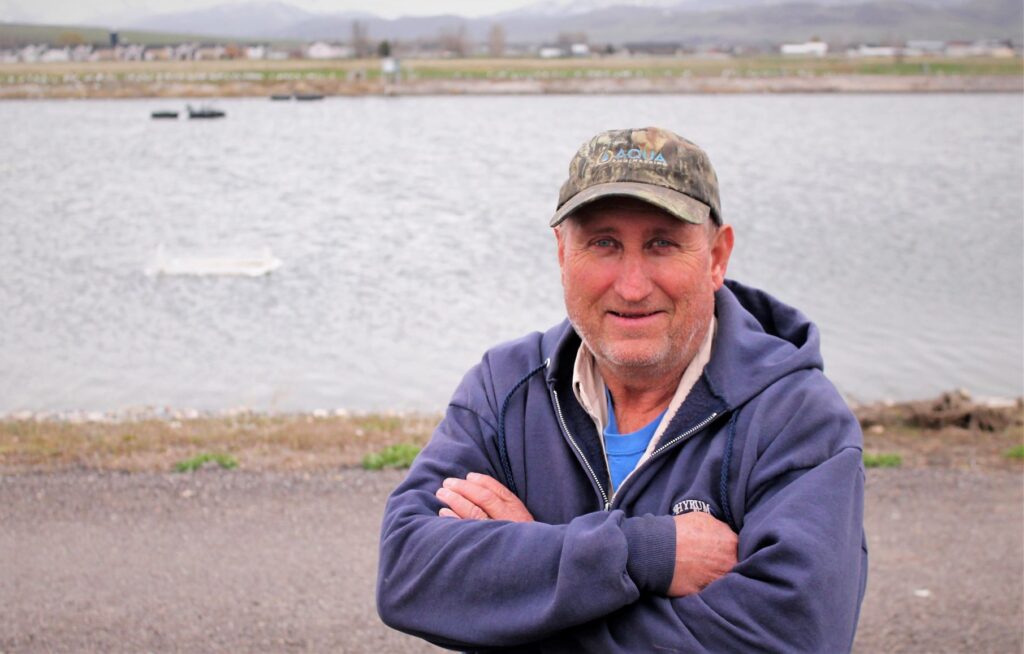Kevin Maughn, Hyrum City’s watermaster superintendent, stands in front of Hyrum’s 50 million gallon pond used for secondary watering of lawns and gardens.
HYRUM – Every time Hyrum residents flush their toilet they ad water to the city’s secondary water system. The city’s sewer system cleans and filters the water and then pumps it to a reservoir adding to the secondary water system. Secondary water in Hyrum is something the residents of the city depend on.

Up until now residents used what they wanted, but the Utah legislature changed things mandating all secondary water systems have to be metered. All for the sake of water conservation.
Ron Salvesen, the Hyrum City manager, said they are applying for a portion of the $250 million the state has allocated for secondary water metering. Hyrum City is one of the biggest irrigation companies in Cache Valley.
The Division of Water Resources is administering the program. They claim installing meters on secondary water systems can reduce water use by 20-30 percent. The application period began April 1st and will expire May 15th.
“We will apply for the money,” he said. “All secondary pressurized water systems throughout the state are required to have meters.”
Kevin Maughn, Hyrum City’s watermaster superintendent, said installing water meters on secondary water for lawns and gardens is going to take four or five years to implement.
“We will have to do it in late fall or winter to do it when there is no water in the system,” he said. “It will take a crew of four people four to five hours for each meter.”
He said it depends on the size of the city and how much help they can devote to the project.
Hyrum has a unique secondary water system. The have built a 50-million-gallon pond that is filled with processed and treated sewer water. The water is used as secondary water for residents of Hyrum City.
“The water is supplemented with water from Porcupine Reservoir,” Maughn said. “We get about 1/7 of the water from reused sewer water. During the watering season we go through a million and a half gallons a day.”
To implement the water meter transition is an $8 million proposition.
Although the state has seen a few rain and snow storms in recent weeks as spring runoff begins, the Beehive State remains in a severe drought. This year’s snowpack has little chance of filling many of Utah’s reservoirs used for the state’s water supply.
Brian Steed, executive director of the Department of Natural Resources, says installing 260,000 secondary water meters is going to help the state’s dwindling water supply. Approximately 15 percent of the irrigation companies around the state are already metered.

“Installing secondary meters yields the biggest bang for the buck when you look at the amount of water saved compared to the cost of the meters,” he said. “This commitment from the legislature will fast-track Utah’s water conservation efforts and sends a strong signal that using this precious resource wisely is critical.”
The DWR reported Friday that 28 of Utah’s largest 45 reservoirs are below 55 percent of available capacity. Overall, statewide storage is 58 percent of capacity.
“We can’t expect people to conserve if they don’t know how much they’re using,” said Candice Hasenyager, director of the Utah Division of Water Resources. “Installation of secondary meters can provide both the water provider and the water user with accurate water information so they can make informed waterwise decisions.”
Nate Daugs, the manager of the Cache Water District, said what works for some irrigation companies may not work for all.
“There was no room for discussion,” he said. “Whether it was going to save water or not it is mandated for everyone.”

In Cache Valley there are over 50 irrigation companies. There are some with a two-person board and 20 connections. The current cost to install a retrofitted secondary meter is approximately $2,000 depending on where the valve is located. The Department of Water Quality estimates the cost range to install meters statewide is approximately $450 million to $675 million.
“It is going to be hard for smaller canal companies with say 20 connections to come up with a 20 percent match,” Daugs said. “And if they can come up with the money they are going to have to replace it in six or seven years.”
The meters are supposed to last 10 to 15 years, but secondary water is dirty and he thinks they will be replacing them in about half of what they should last.
“The Cache Water District is in favor of conservation and measuring water, but the state legislature is making sure it is going to cost a lot more money,” Daugs said. “Then irrigation companies have to hire someone to monitor the meters. It is slowly getting more expensive.”
He tried to work with the legislative during their session, but they didn’t want to hear about Cache Valley.
Weber Basin Water Conservancy District services Weber and Davis counties. They can restrict the water in those areas. In Cache Valley, there are more than 50 individually-owned irrigation companies and most aren’t even using their full allocation.
“Even if they meter the water, shareholders have the right to use their shares,” he said. “Most of the water is being metered pretty good now and individuals are using under what they are entitled to.”

Applications for grants are available to all secondary water providers. Up to 70 percent of the project cost is available in grants. Low-interest loan funds are also available to help with the local cost-share.
Utah Rivers Council claims Utah farmers and ranchers use about 85 percent of Utah’s water. Lawn and garden watering takes about three to four percent of the state’s supply of water.
Secondary water providers can apply to water.utah.gov/secondarymetergrants.

